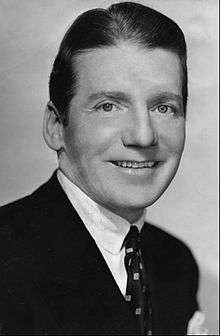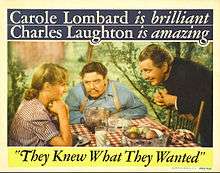Frank Fay (American actor)
| Frank Fay | |
|---|---|
 in 1936 | |
| Born |
Francis Anthony Donner November 17, 1891 San Francisco, California, U.S. |
| Died |
September 25, 1961 (aged 69) Santa Monica, California, U.S. |
| Resting place | Calvary Cemetery, Los Angeles |
| Years active | 1918–1955 |
| Spouse(s) |
Frances White (m. 1917–1917) Lee Buchanan (m. 19??; div. 19??) |
| Children | 1 |
Frank Fay (born Francis Anthony Donner; November 17, 1891 – September 25, 1961) was an American vaudeville comedian and film and stage actor. For a time a well known and influential star, he later fell into obscurity, in part because of his abrasive personality and fascist political views. He is considered an important pioneer in stand up comedy. He played the role of "Elwood P. Dowd" in the Broadway play Harvey by the American playwright Mary Coyle Chase.[1] He is best known as actress Barbara Stanwyck's first husband. Their troubled marriage is thought by some to be the basis of the 1937 film A Star is Born, in which the previously unknown wife shoots to stardom while her husband's career goes into sharp decline.[2] Fay was notorious for his bigotry and alcoholism, and according to the American Vaudeville Museum, "even when sober, he was dismissive and unpleasant, and he was disliked by most of his contemporaries".[1]
Early life and career
Born as Francis Anthony Donner in San Francisco, California, to Irish Catholic parents, he took the professional name of Frank Fay after concluding that his birth name was not suitable for the stage.[3] He enjoyed considerable success as a variety artist starting around 1918, telling jokes and stories in a carefully planned "off the cuff" manner that was very original for the time. Jack Benny stated that he modeled his early stage character on Fay. During the 1920s, Fay was vaudeville's highest-paid headliner, earning $17,500 a week.[3]
When talkies arrived, Warner Bros. studio was eager to put him under contract along with a host of other famous stage personalities. Fay was cast as master of ceremonies in Warner Bros.' most expensive production of 1929, the all-star color all-talking revue The Show of Shows (1929).[3] Based on the success of that film, Fay was quickly signed up for an all-Technicolor musical comedy entitled Under a Texas Moon (1930), in which he also displayed his singing abilities. The movie was a box office success and made a hit of the theme song, also titled "Under a Texas Moon". Fay sang the theme song several times throughout the picture. Another expensive picture, Bright Lights (1930), an extravagant all-Technicolor musical, quickly followed. Fay also starred in The Matrimonial Bed (1930), a Pre-Code comedy in which he sang the song "Fleur d'Amour" twice. Fay quickly found himself associated with musical films, and this led to a decline in his popularity when public interest in musical films began to wane in the late 1930s.
In his next film, God's Gift to Women (1931), the musical sequences were cut for the American release, though they were retained for other countries. Fay failed to get the rave reviews he had previously enjoyed. He attempted to produce his own picture in 1932 and struck a deal with Warner Bros. to have them release his film. This film was titled A Fool's Advice (1932) and proved to be only moderately successful.


Fay married Barbara Stanwyck in 1928, when she was relatively unknown. He helped her jump-start her career in films, and she was given a contract by Warner Bros. late in 1930. Their only film appearance together was a brief skit in the short film The Stolen Jools (1931). They adopted a son, Dion, on December 5, 1932. The marriage reportedly soured when Fay's career was eclipsed by Stanwyck's success, and they divorced in 1935.
Fay's Broadway talent and early success in talkies with his pre-Code risque humor did not bode well with the rising conservative movement ushered in by the Great Depression. Fay played in a series of films in which he was cast as a debonair lover, irresistible to women, that frequently threw in suggestive jokes (e.g., on homosexuality and sex). He was successful as a revue and nightclub comedian and master of ceremonies and appeared frequently on radio shows. He was cast in a bit part as master of ceremonies in the night club sequence of Nothing Sacred (1937).
As late as the 1950s, one of his most enduring routines was taking a popular song and analysing the "senseless" lyrics, for example "Tea for Two":
- ""Picture you, upon my knee." (This guy just owns one chair?)
- "Just tea for two and two for tea, me for you, and you for me, alone"
- So, here's the situation: the guy just has one chair, but enough tea for two, so he has two for tea. If anyone else shows up, he shoots 'em!
- "Nobody near us, to see us or hear us." Who'd want to listen to a couple of people drinking tea?
- "We won't have it known, dear, that we own a telephone."
- So, this guy's too cheap to get another chair, he has a telephone, but won't tell anyone about it!
- "Dawn will break, and you'll awake, and start to bake a sugar cake."
- Oh, this poor woman's life, I can see it now. Dawn breaks, and she's got to start baking, can't even run a brush through her hair, down in the dark, feeling around for the flour...
- "For me to take for all the guys to see."
- I can see that! "Hey, guys, I've got something the wife gave me!"
- Is it a new tie? Is it a set of tires?
- Nahhh- it's a sugar cake! Three layers, with a coconut cream filling!
- "Oh, that's just ducky!," they all say, and they crown him with it.
Later years and death
Fay made a brief screen comeback in 1943 for the low-budget Monogram Pictures. He was teamed with comedian Billy Gilbert for a series of wartime comedies, but walked out after the opener, Spotlight Scandals. Fay was replaced by another comedian more congenial to Gilbert, Shemp Howard.
In January 1946, just months after Nazi Germany had been defeated, a rally of 10,000 white supremacists gathered at Madison Square Garden for a pro-Fascist event called "The Friends of Frank Fay".[4]
After the end of World War II, he had third billing in a movie called Love Nest. Although very talented, Fay was disliked by most of the people he worked with because of his enormous ego. Actor Robert Wagner wrote that Fay was "...one of the most dreadful men in the history of show business. Fay was a drunk, an anti-Semite, and a wife-beater, and Barbara [Stanwyck] had had to endure all of that",[5] while according to actor and comedian Milton Berle "Fay's friends could be counted on the missing arm of a one-armed man." Berle, who was Jewish, claimed to have once hit Fay in the face with a stage brace after Fay, on seeing Berle watching his act from offstage, called out, "Get that little Jew bastard out of the wings".[6]
Shortly before his death, Fay was declared legally incompetent.[7] On September 20, 1961, he was admitted to St. John’s Hospital in Santa Monica, California. He died there one week later, aged 69, of an undisclosed illness. Fay was buried in Calvary Cemetery in Los Angeles.[8]
Honors
Fay has two stars on the Hollywood Walk of Fame.[9]
Filmography
- The Show of Shows (1929)
- Under a Texas Moon (1930)
- The Matrimonial Bed (1930)
- Bright Lights (1930)
- God's Gift to Women (1931)
- A Fool's Advice (1932)
- Meet the Mayor (1932)
- Stars Over Broadway (1935)
- They Knew What They Wanted (1940)
- Spotlight Scandals (1943)
- Love Nest (1951)
References
- 1 2 "Frank Fay". American Vaudeville Museum. Retrieved March 23, 2012.
- ↑ Haskell, Molly (5 January 2014). "A Girl Named Ruby". The New York Times. Retrieved 5 January 2014.
- 1 2 3 "Frank Fay". Los Angeles Times. September 27, 1961.
- ↑ "The Fascist Stand-Up Comic" by Kliph Nesteroff
- ↑ Wagner, Robert (2010). Pieces of My Heart: A Life. Random House. p. 63. ISBN 9780099538356. Retrieved July 17, 2014.
- ↑ Trav, S.D. (November 21, 2013). "Father to Hope, Carson, Leno and Letterman". The Villager. Retrieved July 17, 2014.
- ↑ Byrne, James Patrick; Coleman, Phillip; King, Jason Francis, eds. (2008). Ireland and the Americas: Culture, Politics, and History: A Multidisciplinary Encyclopedia, Volume 2. ABC-CLIO. p. 327. ISBN 1-851-09614-0.
- ↑ Ellenberger, Allan R. (2001). Celebrities in Los Angeles Cemeteries: A Directory. McFarland & Company Incorporated Pub. p. 18. ISBN 0-786-40983-5.
- ↑ "Frank Fay". Hollywood Walk of Fame (walkoffame.com). Retrieved March 23, 2012.
External links
| Wikimedia Commons has media related to Frank Fay (American actor). |
- Frank Fay on IMDb
- Frank Fay at the Internet Broadway Database

- Frank Fay at Find a Grave
- Frank Fay at Virtual History
- The Fascist Stand Up Comic
- The First Stand-Up Comic